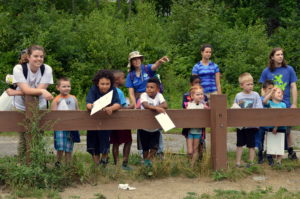Audubon and Providence Parks bring nature to the neighborhood
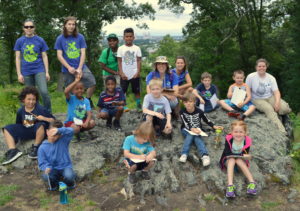
Campers, counselors, and director Lisa Maloney at the top of Neutakonconet Hill with the Providence skyline in the background.
The line of a dozen children has traveled all of 100 yards when one child calls out, “I don’t know where I am!” Kimmie Lavoie, assistant camp director, has just the answer. “Come here,” she says, leading the group of six- to eight-year-olds to a map painted on a building. She points out the different trails, as well as habitats and animals likely to exist on their hike. The list includes woods and meadows, and the animals range from ants to deer. Satisfied with the explanation, the group moves on.
For the most part, it’s just another morning at Audubon’s Summer Nature Camp. Next week, a group of nine- to twelve-year-olds will visit the same camp. It’s just another day, except for one small factor: this camp is in the heart of the Providence’s Silver Lake/Olneyville section. Situated at the 88-acre Neutakoncanut Park, it’s a location that former senior director of policy Eugenia Marks once called “a hidden jewel in Providence.”

Assistant Director Kimmie Lavoie helps campers orient themselves at Neutakonconet.
“Both children said it was their favorite camp all summer.” – Parent comment
Now in its third year, the Neutakoncanut Summer Camp program serves 15 children a week, teaching them about the elements of nature that exist right outside their own doors. When it began, the camp consisted of three week long sessions. It was so popular that Audubon expanded it to five last year, and once more to its current six sessions. Camp Director Lisa Maloney sees the camp as an important resource to kids who may not have the kind of exposure to the outdoors that others may have.
“We want everyone to come to our refuges, of course, because they’re beautiful places, but not everyone can get to one. That’s why we do after school programs here and take kids out and show them their local park. We show them the kinds of plants and animals and insects that live right in their back yard. Hopefully that will give them a feeling that, ‘This is a place for me, and this is a place that I can enjoy, and wouldn’t it be nice if we could preserve it for everyone to enjoy.’”
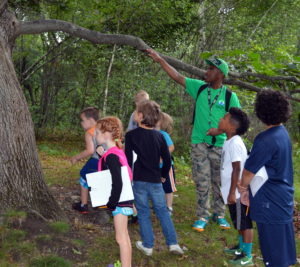
“I found evidence!”
A short distance from the trail map, the group stops at a patch of weeds by the trail. Maloney tells the campers that this is mug wort, which can be crushed up for use as a natural bug repellent. Today’s focus is a scavenger hunt, where kids look for indications that there is habitat to support wildlife: flowers that provide nectar for bees, a chewed pine cone that indicates a visit by a squirrel. “I found evidence!” one camper shouts, pointing to a hole in the tree. The powdery substance around the opening could be a sign that there are ants or termites calling the tree home.
“This week’s theme is ‘Home Sweet Habitat’,” Maloney explains. “Neutakoncanut can represent a lot of habitat around Rhode Island; every day we go to a new section of the park and think about what’s different, what’s the same, and who lives there. We just get them to know the park a little bit.” Themes change weekly and are chosen to suit the unique setting. “Another session is called Our Buggy World, where we find all about “bugs” and their relatives, including spiders, worms, and millipedes. We look into the miniatures. You don’t have to go to a huge place to find insect life!”
Home of Squirrels
According to the Neutakoncanut Hill Conservancy’s web site, the hill was a boundary of land included in a purchase made by Roger Williams from the Narragansetts. They had called it Neutakoncanut, which means “home of squirrels”, a description that certainly hasn’t changed over the centuries. The hill remained in private hands until 1892, when it was purchased by what was then called the Public Park Commission. In recommending its purchase, the Commission wrote, “On this part, Nature has made a natural park more perfect than the hand of man could devise. On a Sunday afternoon as many as 1000 people left their horse-cars on Plainfield St. and ascended the Hill.”
“King started to show interest in plants this spring on our afternoon walks” – Parent comment
The nature camp is a partnership between Audubon and the Partnership for Providence Parks (PPP). Maloney says it began when someone at Providence Parks suggested a nature camp. “They thought it would be nice to offer one of those camps at our parks, but they didn’t have the staff. That’s when they contacted Audubon.” From concept to funded fruition, the camp was five years in the making, but by 2014 the program was ready. Today, the camp not only offers the environmental experience, but it provides campers with breakfast and lunch, all for a very low fee that is supplemented by the city of Providence. For Maloney, the program was a blend of personal and professional.
“I’m a Providence resident, and I discovered the park when I first started working for Audubon in Providence. (Audubon’s former senior director of policy) Eugenia Marks said, ‘Oh, there’s this cool park that is 88 acres, and we’re starting to mark the trails. This is just such a gem, we want everybody to know that there is this place that’s right here, within city limits, besides Roger Williams Park, that exists.’
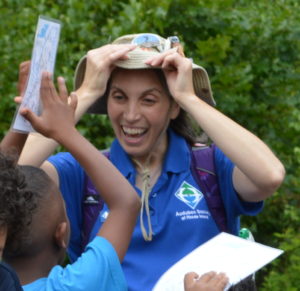
Summer camp director Lisa Maloney.
“Neutakoncanut has a lot of forest, lots of shade. I really got passionate about bringing kids there. We started when we did Audubon’s annual butterfly count. Then came after school programs with middle school students, and we thought that Neutakoncanut would be a great place to bring kids. Then the idea came to use it in the summer. It sort of became this ball that just kept rolling.”
Lauren Parmelee, Audubon’s senior director of education, sees her primary mission as reaching out to urban communities. “We try to do that in after school programs in Providence, Woonsocket, and Central Falls. Ideally, we want to take those kids into their own neighborhoods. We try to show them that nature is not ‘the other’; it’s part of their own neighborhood.”
Audubon put a lot of time and effort into getting programs like the one at Neutakoncanut started, she said. Her job is to help her staff carve out the time when programs can run, find the money to run them, and oversee the curriculum. She credits teaming with Providence Parks with helping make that happen. “It’s such a good partnership. We have our best success when we partner with other agencies, and this is one good example of one that is helping provide a good experience for kids. In this case, families are able to participate because the city’s parks and recs makes it so affordable. Families pay a very low fee, so the camp fills up in like 24 hours, because people find out and see that it’s such a great opportunity at such a low price.”
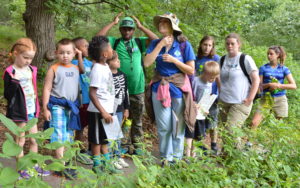
Another, less obvious benefit that the partnership provides is a sense of trust within the communities that house the camps. “April Alix worked at Audubon, and is now the conservation and education coordinator at Partnership for Providence Parks, and she’s been invaluable. She knows that community, and that community knows her. You can’t just walk in and say, ‘Hey, we have this free program.’ You have to have trust. It’s a combination of financial support and trust that gets the kids there.
“Whether we’re doing an after school program at a school or something like this in the park, PPP gives us a venue. We come in and have the expertise in natural history, we have the expertise in educational skills and managing groups of young people and how to have fun, we have live animals. We have all that. But without a venue, an audience, and without monetary support, it’s too hard to do.”

“Both children said it was their favorite camp all summer.” – Parent comment
The campers reach the summit of Neutakoncanut Hill and pause. They line up along a railing by the trail that overlooks a view of Providence that stretches for miles. The view has changed since those “horse cars” written about in 1892 deposited gentlemen in top hats and ladies in voluminous dresses. Still, it isn’t hard to imagine them pausing for a moment here to overlook their city and perhaps considering their place in the world. The campers and staff gather for a group photo, and then it’s off to the meadow.
Here, the kids play “habitat tag”, where anyone tagged must freeze. They must wait until another camper dodges away from the one who is “it” and frees the frozen one. There is a price, though: the frozen camper must recite the elements that they need to “survive”. A boy wearing a t-shirt that reads “The Talent has arrived” reminds a camper half his size of the habitat list she must say before being freed. “Air, water, food, shelter!” she says, rejoining the game.
The next week will offer camp for children nine to twelve years old. For them, the theme will be “Predators and Prey”. “Kids are always interested in predators,” says Maloney. “They love learning about how they catch their food. And how does prey avoid being eaten?” Campers will learn about this through the use of scavenger hunts, where they will look for evidence of both predators and prey. “We call it ‘Who goes there?’ We teach the kids about animal tracking. We don’t always see charismatic megafauna (the general term for larger animals that often hide themselves during the daytime). The scavenger hunt will make us use detective skills to see signs. We will look for galls, scat, scratches on trees, and just try to interpret what those signs mean. There are definitely deer and raccoons at Neutakoncanut, even though we can’t see them. Even things like deer browse (the chew marks on plants and shrubs) are clues that large animals are here. We are arming them with the skills to figure out what’s happening in the park even when we’re not around.”
I want to learn more about this place.
Lauren Parmelee hopes the camper experience will connect with adults as well. “Ideally, what we do is inspire kids to go home and say ‘Hey, we need to visit this park.’ We want the families to value it. If families buy into it, they will have a better sense of caring and respect for their parks.” With the success of Neutakoncanut, Parmelee says it’s possible that the idea will be taken elsewhere. “We may try a camp in another park that has both indoor space and an outdoor venue. This camp is certainly well run enough so that we could create one in a new place.”
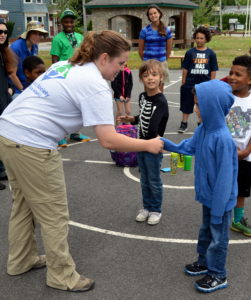
Kimmie Lavoie playing games with the campers.
Lisa Maloney shares that perspective. “The reason Audubon is interested in this camp is that the park is a great laboratory for learning about the science lessons that the kids are already learning about in school. Having these outside lessons really cements it for them, because they’re seeing it, they’re hearing it, they’re smelling it, they’re down and dirty learning about it. Eventually it becomes a case of ‘I want to learn more about this place and how to protect it because I enjoy being in this space.’ We’re hoping this begins to generate conservation minded adults who had this experience when they were kids, who will look at a meadow and not just think of it as a bunch of grass. We really want to inspire the next generation to come to a park that’s within their own city and begin to conserve those areas. ”
